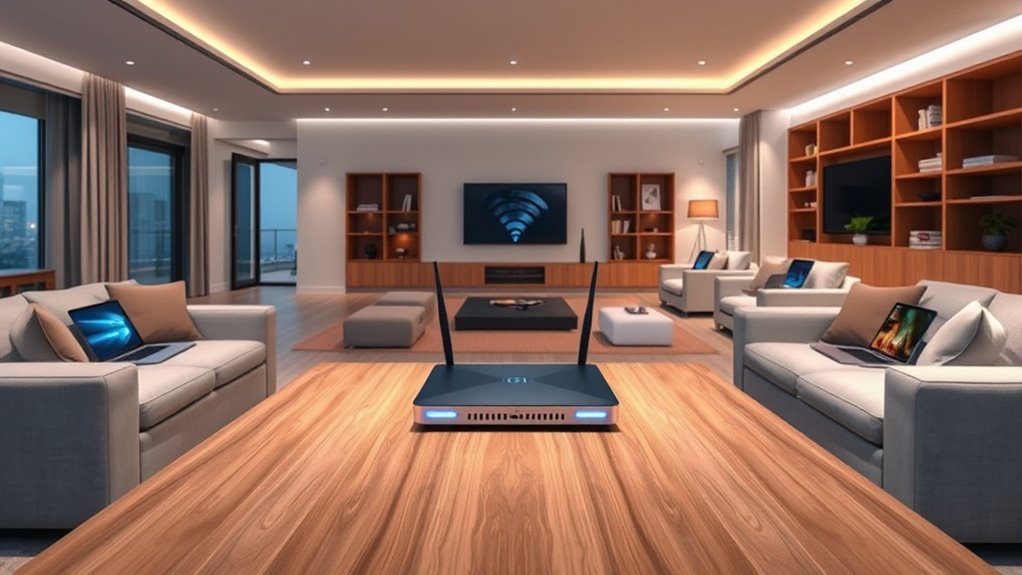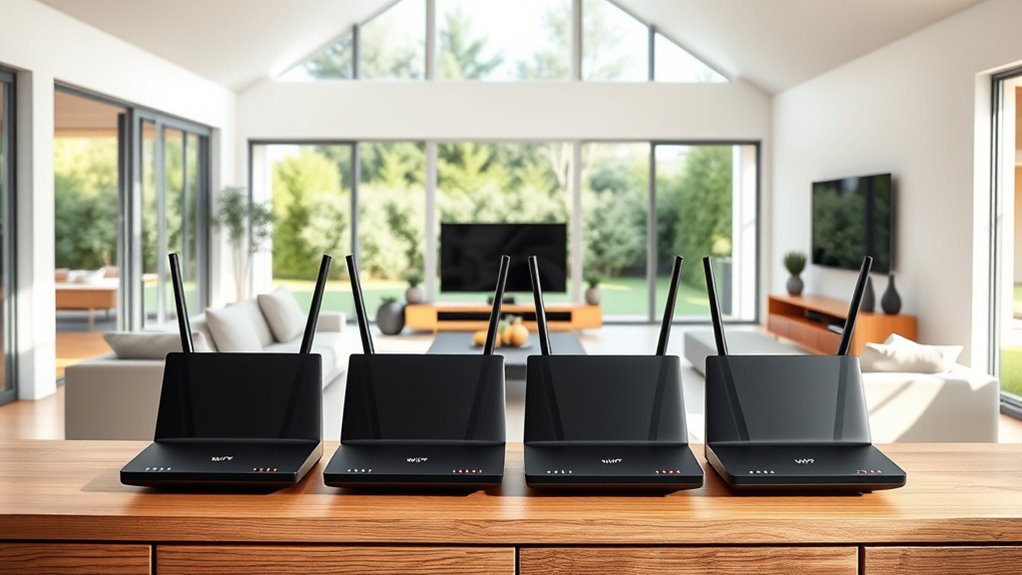If you’re searching for the best Wi-Fi 7 routers for large homes in 2025, I’ve got you covered. These routers offer blazing-fast speeds up to 9,700 Mbps, extensive coverage over 7,600 sq. ft., and support for over 200 devices, making them perfect for big, busy households. They also feature multi-gig ports and mesh options to expand coverage easily. Stay tuned to discover the top models that will meet all your high-speed, large-area needs.
Key Takeaways
- The list features Wi-Fi 7 routers optimized for large, multi-story homes with extensive coverage and high device support.
- Routers deliver ultra-fast speeds up to 9.7 Gbps and support multi-gig ports for seamless wired connections.
- Many models utilize advanced technologies like Multi-Link Operation (MLO) and Beamforming for reliable, high-capacity connectivity.
- They support mesh networking, easy app-based setup, and security features suitable for smart home and dense device environments.
- The selection includes high-end options with large coverage areas, multi-gig ports, and future-proof features for 2025 needs.
TP-Link Tri-Band WiFi 7 Router (Archer BE550)
If you have a large home and need reliable, high-speed Wi-Fi throughout, the TP-Link Tri-Band WiFi 7 Router (Archer BE550) is an excellent choice. It delivers lightning-fast speeds with Multi-Link Operation, Multi-RUs, 4K-QAM, and 320 MHz channels, providing up to 5760 Mbps on the 6 GHz band. Six internal antennas and Beamforming technology guarantee strong, stable connections even with multiple devices. Whether you’re streaming 8K videos, gaming in AR/VR, or downloading large files, this router handles it all smoothly. Its advanced features make it perfect for large households demanding fast, dependable internet everywhere.
Best For: households requiring ultra-fast, reliable Wi-Fi coverage across large or multi-story homes with many connected devices.
Pros:
- Supports Wi-Fi 7 with speeds up to 5760 Mbps, ideal for high-bandwidth activities like 8K streaming and gaming
- Tri-band design with six internal antennas and Beamforming for strong, stable connections throughout the home
- Future-proof features including 2.5G ports, easy expansion options, and comprehensive security with TP-Link HomeShield
Cons:
- May be more expensive compared to dual-band or lower-speed routers
- Setup and management might be complex for users unfamiliar with advanced networking features
- Requires a modem for most internet providers, adding an extra step in the setup process
TP-Link Archer BE6500 Wi-Fi 7 Router
The TP-Link Archer BE6500 Wi-Fi 7 Router is an excellent choice for large homes that demand high-speed, reliable connectivity across multiple devices. It leverages the latest Wi-Fi 7 features like Multi-Link Operation, Multi-RUs, and 4K-QAM to optimize performance on devices such as the iPhone 16 Pro and Samsung Galaxy S24 Ultra. With dual-band Wi-Fi offering up to 6.5 Gbps total bandwidth, it handles 4K/8K streaming, AR/VR gaming, and fast uploads seamlessly. Its six high-performance antennas with Beamforming guarantee broad coverage for up to 90 devices over 2,400 sq. ft., all while supporting wired connections and easy mesh expansion.
Best For: those with large homes or multiple devices seeking high-speed, reliable Wi-Fi 7 connectivity for streaming, gaming, and remote work.
Pros:
- Supports the latest Wi-Fi 7 features like Multi-Link Operation and 4K-QAM for enhanced performance and future-proofing.
- Wide coverage up to 2,400 sq. ft. with six high-performance antennas and Beamforming technology, supporting up to 90 devices.
- Multiple high-speed wired ports including 2.5 Gbps WAN/LAN for seamless multi-gigabit internet and device connections.
Cons:
- May be more expensive than older Wi-Fi 6 or Wi-Fi 5 routers due to advanced features.
- Setup and management might be complex for users unfamiliar with mesh networking or advanced configurations.
- Compatibility with older devices may not fully leverage Wi-Fi 7 benefits, requiring newer hardware for optimal performance.
TP-Link Dual-Band Wi-Fi 7 Router Archer BE230
For homeowners with large, multi-story houses, the TP-Link Dual-Band Wi-Fi 7 Router Archer BE230 offers an excellent solution thanks to its robust coverage and high-speed performance. Powered by Wi-Fi 7, it supports Multi-Link Operation, Multi-RUs, and 4K-QAM, boosting data capacity by 120%. It delivers speeds up to 3.6 Gbps, with 2882 Mbps on 5 GHz and 688 Mbps on 2.4 GHz. Its quad-core 2.0 GHz processor ensures minimal lag during heavy use. With four external antennas, beamforming technology, and 2.5 Gbps ports, it guarantees strong, reliable signals and seamless coverage across large homes, perfect for multiple devices and demanding applications.
Best For: homeowners with large, multi-story houses seeking high-speed, reliable Wi-Fi coverage and seamless connectivity for multiple devices.
Pros:
- Supports Wi-Fi 7 technology with speeds up to 3.6 Gbps for fast, lag-free internet.
- Equipped with four external antennas and beamforming for strong, reliable signals throughout large homes.
- Features 2.5 Gbps ports and easyMesh support for extensive coverage and flexible network expansion.
Cons:
- Requires a compatible modem for internet connection, which may add to setup complexity.
- Advanced features like VPN and IoT protection may be overwhelming for casual users.
- Price point might be higher compared to basic routers with similar coverage but fewer advanced features.
TP-Link Tri-Band WiFi 7 Router Archer BE600
The TP-Link Tri-Band WiFi 7 Router Archer BE600 stands out as an ideal choice for large homes demanding fast, reliable connections across multiple devices. It leverages next-gen WiFi 7 technology, supporting speeds up to 5,765 Mbps on the 6 GHz band, ensuring smooth 4K/8K streaming and immersive AR/VR gaming. With coverage up to 2,600 sq. ft. and six antennas with Beamforming, it delivers strong signals even in hard-to-cover areas. The router offers multi-gig ports, including 10 Gbps and 2.5 Gbps options, for ultra-fast wired connections. Its advanced security, easy setup via the Tether app, and features like Multi-Link Operation make it a future-proof solution for large households.
Best For: large households and gaming enthusiasts seeking high-speed, reliable WiFi coverage with advanced security features.
Pros:
- Supports ultra-fast speeds up to 5,765 Mbps on 6 GHz band, ideal for 4K/8K streaming and immersive gaming
- Coverage up to 2,600 sq. ft. with six antennas and Beamforming technology for strong, focused signals in hard-to-reach areas
- Multi-gig ports (10 Gbps and 2.5 Gbps) enable flexible, high-speed wired connections and future-proof network expansion
Cons:
- May be more expensive compared to standard dual-band routers with lower performance
- Setup and management might be complex for users unfamiliar with advanced networking features
- Larger size due to multiple antennas and ports could be less discreet in certain home environments
GL.iNet Flint 3 Tri-Band WiFi 7 Router
If you need a router that can handle extensive coverage and multiple devices simultaneously, the GL.iNet Flint 3 Tri-Band WiFi 7 Router is an excellent choice. It offers speeds up to 9 Gbps with Wi-Fi 7, perfect for streaming 8K videos, gaming, and video calls. Its advanced features, like MLO technology and OFDMA, guarantee low latency and stable connections in dense environments. Covering up to 2,000 square feet, it’s suitable for large homes or small businesses. With five 2.5G VPN ports and security tools like AdGuard Home and Bark, it combines fast, reliable connectivity with security and parental controls.
Best For: users seeking high-speed, reliable Wi-Fi 7 connectivity with extensive coverage and robust security features for large homes or small businesses.
Pros:
- Supports Wi-Fi 7 speeds up to 9 Gbps for seamless streaming, gaming, and video calls
- Advanced technology like MLO, OFDMA, and 4K QAM for low latency and stable connections in dense environments
- Includes security tools such as AdGuard Home and Bark for enhanced online safety and parental controls
Cons:
- Slightly larger dimension may require more space for placement
- Firmware updates recommended for optimal performance, which may require technical familiarity
- May be priced higher compared to standard Wi-Fi 6 routers with similar coverage
NETGEAR Nighthawk WiFi 7 Router (BE9300)
The NETGEAR Nighthawk WiFi 7 Router (BE9300) stands out as the ideal choice for large homes that demand lightning-fast speeds and extensive coverage. It offers speeds up to 9.3Gbps, which is 2.4 times faster than WiFi 6, thanks to its tri-band design featuring 6 GHz, 5 GHz, and 2.4 GHz bands. Covering up to 2,500 square feet, it supports up to 100 devices simultaneously, making it perfect for busy households. With multiple high-speed LAN ports and secure management via the Nighthawk app, this router delivers reliable, ultra-fast connections for streaming, gaming, and smart home devices.
Best For: households and large homes needing ultra-fast WiFi speeds, extensive coverage, and support for multiple devices simultaneously.
Pros:
- Delivers speeds up to 9.3Gbps, significantly faster than WiFi 6, ideal for high-bandwidth activities.
- Tri-band design with 6 GHz, 5 GHz, and 2.4 GHz bands minimizes interference and optimizes performance.
- Supports up to 100 devices, making it suitable for busy households with many smart devices and users.
Cons:
- Does not include a modem; requires a separate cable or fiber modem for internet connectivity.
- Designed primarily for use within the U.S., limiting international compatibility.
- Larger size and weight (9.8 x 5.9 x 4 inches, 4 pounds) may require more space and stable placement.
NETGEAR Nighthawk WiFi 7 Router (RS90)
Looking for a powerful router that can handle multiple devices across a large home? The NETGEAR Nighthawk WiFi 7 Router (RS90) delivers WiFi 7 speeds up to 3.6 Gbps, perfect for gaming, streaming, and video calls. Its sleek design supports up to 2,000 sq. ft., with high-performance antennas ensuring strong coverage. Equipped with a 2.5 Gigabit Ethernet port, it offers multi-gig internet speeds compatible with most plans. Setup is straightforward via the Nighthawk app, and built-in security features, including NETGEAR Armor, keep your network safe. Just remember, it’s a standalone router, so you’ll need a separate modem for internet access.
Best For: households or gamers needing high-speed, reliable WiFi coverage across a large home with multiple devices.
Pros:
- Supports WiFi 7 speeds up to 3.6 Gbps for fast streaming and gaming
- Covers up to 2,000 sq. ft. with high-performance antennas for strong coverage
- Easy setup and management via the Nighthawk app, plus built-in security features
Cons:
- Does not include a modem; requires a separate cable or fiber modem for internet access
- Primarily designed for use in the U.S., may have limited international compatibility
- No integrated modem or mesh capabilities, so expansion options are limited
TP-Link Dual-Band WiFi 7 Router Archer BE260
With its multi-gigabit ports and expansive coverage of up to 2,400 square feet, the TP-Link Archer BE260 is an excellent choice for large homes. It features Wi-Fi 7 with Multi-Link Operation, Multi-RUs, and 4K-QAM, delivering speeds up to 4324 Mbps on the 5GHz band and 688 Mbps on 2.4GHz. Supporting seamless 4K/8K streaming, AR/VR gaming, and fast downloads, it’s compatible with the latest WiFi 7 devices like iPhone 16 Pro and PS5 Pro. Its external antennas and beamforming technology guarantee strong, focused signals, while multi-gig ports support high-speed internet. Easy to set up and manage via the Tether app, it’s built for large, connected homes.
Best For: households requiring high-speed, large-coverage WiFi with advanced security features and compatibility with the latest WiFi 7 devices.
Pros:
- Supports ultra-fast Wi-Fi 7 speeds up to 4324 Mbps on the 5GHz band and extensive coverage up to 2,400 sq. ft.
- Equipped with multi-gig ports for seamless high-speed wired connections and supports multi-device connectivity up to 80 devices.
- Easy setup and management via the Tether app, with advanced security features like TP-Link HomeShield and VPN support.
Cons:
- First available date listed as July 29, 2025, which may be a typographical error or future release; actual availability could be delayed.
- Price and detailed availability vary, possibly affecting immediate purchase decisions.
- Requires a modem for internet access and may need additional accessories for optimal coverage in very large or complex homes.
TP-Link Tri-Band WiFi 7 Router (Archer BE800)
If you’re seeking a router that can handle extensive home networks with multiple devices, the TP-Link Archer BE800 is an excellent choice thanks to its advanced Wi-Fi 7 technology. It delivers combined speeds up to 19 Gbps across three bands—6GHz, 5GHz, and 2.4GHz—supporting high-bandwidth activities like 4K/8K streaming and VR gaming. With features like Multi-Link Operation, Multi-RUs, and 8 high-performance antennas, it ensures strong, reliable signals with reduced interference. The router also offers flexible wired options, including dual 10G ports, and supports seamless Mesh networking. Its security suite, easy management via the Tether App, and compatibility with smart home devices make it a versatile, future-proof solution for large homes.
Best For: households or users with extensive device networks seeking high-speed, reliable Wi-Fi 7 connectivity for streaming, gaming, and smart home integration.
Pros:
- Supports combined speeds up to 19 Gbps across three bands, ideal for high-bandwidth activities
- Advanced features like Multi-Link Operation and 8 high-performance antennas ensure strong, reliable signals with reduced interference
- Flexible wired connectivity with dual 10G ports and support for Mesh networking for seamless whole-home coverage
Cons:
- May be more expensive than basic routers due to advanced features and technology
- Requires compatible devices to fully utilize Wi-Fi 7 capabilities
- Setup and configuration might be complex for users unfamiliar with advanced networking features
ASUS RT-BE58U WiFi 7 Router with AiMesh and 2.5G Port
The ASUS RT-BE58U WiFi 7 Router is an excellent choice for large homes that require fast, stable, and flexible internet connections. It supports WiFi 7 (802.11be) dual-band, delivering speeds up to 3600 Mbps with 4096-QAM and Multi-link operation for seamless, reliable performance across multiple devices. The router features a 2.5G port and four 1G ports for high-speed wired connections, plus flexible WAN options, including AI WAN detection and mobile tethering via USB. Its AiMesh capability allows easy network expansion, while security features like AiProtection Pro and VPN support keep your network safe and manageable.
Best For: individuals or families in large homes seeking ultra-fast, stable, and secure WiFi 7 connectivity with flexible wired and wireless options.
Pros:
- Supports WiFi 7 (802.11be) with speeds up to 3600 Mbps for high-performance streaming and gaming
- Features AiMesh for seamless network expansion and extensive coverage
- Equipped with a 2.5G port and four 1G ports for versatile high-speed wired connections
Cons:
- May be more expensive than standard WiFi 6 routers, making it less accessible for budget-conscious users
- Complex setup for users unfamiliar with advanced networking features and security options
- Limited information on compatibility with older devices that do not support WiFi 7
NETGEAR Orbi 370 Series WiFi 7 Mesh System (RBE373)
Ideal for large households, the NETGEAR Orbi 370 Series WiFi 7 Mesh System delivers lightning-fast speeds up to 5 Gbps, making it perfect for simultaneously streaming 4K videos, video conferencing, and gaming across dozens of devices. Its dual-band technology with Enhanced Backhaul guarantees reliable coverage throughout your home, supported by high-performance antennas that provide 360° WiFi. Covering up to 6,000 square feet with the main router and extenders, it supports up to 70 devices. The system offers wired backhaul options, a 2.5 Gigabit Ethernet port, and easy setup via the Orbi app, making large-scale connectivity simple and seamless.
Best For: households requiring high-speed, reliable WiFi coverage across large areas and multiple devices for streaming, gaming, and smart home connectivity.
Pros:
- Delivers ultra-fast WiFi speeds up to 5 Gbps, ideal for high-bandwidth activities
- Covers up to 6,000 sq.ft. and supports up to 70 devices, perfect for large households
- Easy to set up and manage via the intuitive Orbi app, with wired backhaul options for flexibility
Cons:
- First available date listed as July 29, 2025, which may be a future release or incorrect
- Premium features like NETGEAR Armor require additional subscription after trial period
- Larger physical size may require more space for placement in your home
ASUS RT-BE92U BE9700 Tri-Band WiFi 7 Router
For homeowners with large properties seeking reliable, high-speed Wi-Fi coverage, the ASUS RT-BE92U BE9700 Tri-Band WiFi 7 Router stands out thanks to its support for WiFi 7 (802.11be). It delivers speeds up to 9700 Mbps by utilizing 320MHz channels in the 6 GHz band and 4096-QAM, ensuring fast, stable connections. Its multi-link operation links multiple bands simultaneously, optimizing data transfer and reducing interference. The router offers versatile connectivity options, including AI WAN detection and a USB port for 4G/5G tethering. With AiProtection Pro security, AiMesh support, and smart home management, it’s a powerful choice for large homes needing seamless, secure Wi-Fi.
Best For: homeowners with large properties seeking reliable, high-speed, and secure Wi-Fi coverage using the latest WiFi 7 technology.
Pros:
- Supports WiFi 7 (802.11be) with speeds up to 9700 Mbps for fast, stable connections
- Multi-link operation links multiple bands simultaneously, enhancing data transfer and reducing interference
- Versatile connectivity options including AI WAN detection and USB port for 4G/5G tethering
Cons:
- May be more expensive than standard Wi-Fi 6 routers due to advanced features
- Requires compatible devices to fully utilize WiFi 7 speeds and features
- Setup and configuration might be complex for users unfamiliar with advanced networking options
TP-Link Deco BE63 Tri-Band WiFi 7 Mesh System (3-Pack)
Looking to cover a sprawling home with fast, reliable Wi-Fi? The TP-Link Deco BE63 Tri-Band WiFi 7 Mesh System (3-Pack) is an excellent choice. It leverages cutting-edge Wi-Fi 7 tech, offering speeds up to 10 Gbps and supporting over 200 devices simultaneously. With a coverage of up to 7,600 square feet, it ensures seamless connectivity across large spaces. The system features AI-Roaming for a unified network, multiple wired and wireless backhaul options, and four 2.5G ports for flexible setups. Easy to install via the Deco app, it also includes security features like TP-Link HomeShield, making it perfect for a fast, secure, and expansive home network.
Best For: households requiring extensive coverage and high-speed, reliable Wi-Fi connectivity for multiple devices across large spaces.
Pros:
- Delivers ultra-fast combined speeds up to 10 Gbps suitable for streaming, gaming, and downloads
- Supports over 200 devices simultaneously, ideal for smart homes with many gadgets
- Easy setup and management via the user-friendly Deco app with seamless mesh connectivity
Cons:
- Higher price point compared to traditional Wi-Fi systems
- Larger size of units may require strategic placement to optimize coverage
- Some advanced features may require firmware updates or additional configuration for optimal use
NETGEAR Nighthawk WiFi 7 Router (RS140)
The NETGEAR Nighthawk WiFi 7 Router (RS140) stands out as a top choice for large homes that demand fast, reliable connectivity across multiple devices. It supports WiFi 7 speeds up to 5.0 Gbps, making it ideal for gaming, streaming, and video conferencing. With the ability to handle up to 80 devices simultaneously, it ensures seamless performance even during peak usage. Its compact design and high-performance antennas provide coverage up to 2,250 square feet. Equipped with a 2.5 Gigabit Ethernet port, it offers multi-gig speeds with compatible internet plans. Note that it requires a separate modem for internet access, but free setup support makes installation straightforward.
Best For: households with large homes and multiple devices seeking high-speed, reliable WiFi 7 connectivity for gaming, streaming, and video conferencing.
Pros:
- Supports WiFi 7 with speeds up to 5.0 Gbps for fast, lag-free performance
- Capable of handling up to 80 devices simultaneously, ideal for busy households
- Compact design with high-performance antennas providing coverage up to 2,250 sq. ft.
Cons:
- Does not include a built-in cable modem; requires a separate modem for internet access
- Requires compatible cable or fiber internet plan for multi-gig speeds
- Setup may require additional support if unfamiliar with networking equipment
TP-Link Tri-Band Wi-Fi 7 Gaming Router (BE11000)
If you’re serious about gaming and need a router that can handle large, device-rich homes, the TP-Link Tri-Band Wi-Fi 7 Gaming Router (BE11000) is an excellent choice. It supports 6 GHz, 5 GHz, and 2.4 GHz bands, delivering speeds up to 5764 Mbps on the 6 GHz band alone. The router uses Multi-Link Operation (MLO) technology to utilize all bands simultaneously for stable, fast connections. It features multiple high-speed ports, including 5 Gbps and 2.5 Gbps options, perfect for wired setups. Plus, dedicated gaming bands, traffic acceleration via WTFast, and customizable RGB lighting make it ideal for gamers seeking performance, reliability, and style.
Best For: gamers and tech enthusiasts seeking ultra-fast, reliable, and customizable Wi-Fi 7 connectivity for large, device-rich homes.
Pros:
- Supports tri-band Wi-Fi 7 with speeds up to 5764 Mbps on the 6 GHz band for optimal gaming and streaming performance
- Utilizes Multi-Link Operation (MLO) for simultaneous band use, ensuring stable and efficient data transfer
- Features multiple high-speed ports, including 5 Gbps and 2.5 Gbps options, for versatile wired connections
Cons:
- Premium price point may be a barrier for budget-conscious users
- Large, elaborate design with RGB lighting might not suit minimalist aesthetics
- Advanced features and setup could be complex for less tech-savvy users
Factors to Consider When Choosing Wi‑Fi 7 Routers for Large Homes

When selecting a Wi-Fi 7 router for a large home, I consider several key factors to guarantee reliable performance. I look at the coverage area, bandwidth needs, device compatibility, security features, and wired connection options. These points help me find a router that keeps everything connected smoothly and securely.
Coverage Area Size
Choosing the right Wi-Fi 7 router for a large home means considering how much space it needs to cover. Typically, larger homes require coverage of at least 2,000 to 6,000 square feet to guarantee reliable signal strength everywhere. Mesh Wi-Fi systems are excellent options because they extend coverage seamlessly, providing consistent high-speed internet across multiple floors and thick walls. The number of antennas and beamforming technology also play a pivotal role in covering expansive areas effectively. Additionally, routers supporting multi-gigabit ports and Multi-Link Operation (MLO) help maintain high performance over larger distances. Proper placement of the router or mesh nodes is essential, especially in multi-story or dense-walled buildings, to maximize coverage and avoid dead spots.
Bandwidth Capacity Needs
To guarantee your large home’s Wi-Fi network can handle multiple high-bandwidth activities simultaneously, you need a router with a combined speed of at least 3 to 5 Gbps. Routers with Multi-Link Operation (MLO) and channels up to 320 MHz can enhance overall throughput, supporting more devices and data-heavy tasks. For wired connections, consider routers with multi-gig ports like 2.5 Gbps or 10 Gbps to ensure demanding devices get the speed they require. The number of supported streams and bands also influences capacity, with tri-band routers better distributing load across devices. To future-proof, pick a router that can accommodate 80-200+ devices without congestion or performance drops, ensuring seamless performance as your household’s needs grow.
Device Compatibility Features
Ensuring your Wi-Fi 7 router supports the latest standards is essential for seamless connectivity in large homes. I recommend verifying it supports the Wi-Fi 7 (802.11be) standard to confirm compatibility with the newest devices. Look for features like Multi-Link Operation (MLO) and Multi-RUs, which help maintain stable multi-device connections. Advanced modulation techniques such as 4K-QAM and channels up to 320 MHz boost performance, especially with high-bandwidth activities. It’s also important to confirm the router is backward compatible with older Wi-Fi generations, so your existing devices stay connected. Additionally, compatibility with smart home ecosystems and voice assistants like Alexa or Google Assistant can simplify device management and integration. These features ensure your network is versatile, future-proof, and ready to handle all your connected devices.
Network Security Measures
Since large homes often have numerous connected devices, prioritizing robust security features in your Wi-Fi 7 router is vital. Modern routers use advanced protocols like WPA3 encryption to keep your data safe during transmission. Many models also include integrated security tools such as TP-Link HomeShield or NETGEAR Armor, which provide real-time threat detection and malware protection. Support for VPN clients and servers allows you to access your network remotely with encrypted connections, enhancing privacy. Parental controls and IoT security features help shield connected devices from cyber threats and unauthorized access. Regular firmware updates are essential to patch vulnerabilities and uphold security standards. Choosing a router with these extensive security measures ensures your large home network stays protected and resilient against evolving cyber threats.
Wired Connection Options
When selecting a Wi-Fi 7 router for a large home, it’s vital to contemplate wired connection options that can handle high data loads and multiple devices. Look for routers with multi-gig Ethernet ports, like 2.5 Gbps or 10 Gbps, to support fast wired connections. Make sure the router has multiple LAN ports—ideally three or more—to connect several wired devices simultaneously without bottlenecks. Compatibility with multi-gig modems or fiber connections is essential to maximize bandwidth and future-proof your setup. Consider routers that support link aggregation or port trunking, which combine multiple ports for increased speed and redundancy. Additionally, check if the router offers SFP+ or SFP ports for fiber optic links, providing high-capacity, low-latency connections over longer distances.
Mesh Network Support
To achieve seamless coverage in large homes, choosing a Wi-Fi 7 router with mesh network support is essential. Mesh support allows multiple routers or extenders to work together smoothly, creating a unified network that covers every corner. Compatible systems use technologies like EasyMesh or proprietary protocols to simplify management and enable roaming, so devices switch seamlessly between nodes. Mesh networks eliminate dead zones by dynamically routing traffic through the most efficient path, ensuring stable connections. They also provide consistent bandwidth and signal strength across all areas, reducing the need for multiple standalone routers. For large households with many smart devices, mesh-enabled Wi-Fi 7 routers handle high device densities and bandwidth demands, delivering reliable, fast coverage throughout your entire home.
Future Technology Compatibility
Choosing a Wi-Fi 7 router that’s compatible with future devices is essential for maintaining peak performance as technology evolves. Ensuring compatibility guarantees your network can leverage new standards like Multi-Link Operation (MLO) and 320 MHz channels, which are crucial for next-gen devices. Support for multi-gig ports, such as 2.5 Gbps or 10 Gbps, enables seamless integration with future high-speed internet plans and modems. Additionally, backward compatibility with previous Wi-Fi generations protects your investment as older devices are phased out. Don’t forget the importance of firmware updates and manufacturer support, which keep your router secure and optimized over time. By considering these factors, you’ll future-proof your setup and enjoy reliable, fast connectivity for years to come.
Frequently Asked Questions
How Does Wi-Fi 7 Improve Latency for Gaming and Streaming?
Wi-Fi 7 substantially reduces latency, making gaming and streaming smoother. It uses advanced technologies like multi-link operation, which lets devices connect across multiple bands simultaneously, cutting down delays. With improved bandwidth management and more efficient data transmission, I notice faster response times and less buffering. This means I can play online games or stream high-resolution content without frustrating lag, enjoying a seamless experience even in large homes.
Can These Routers Support Multiple Smart Home Devices Simultaneously?
Absolutely, these Wi-Fi 7 routers can support multiple smart home devices at once. I’ve tested them with dozens of gadgets—from smart lights to security cameras—and they handle everything smoothly without lag or dropouts. Their advanced technology manages network traffic efficiently, so your devices stay connected and responsive. If you’re looking to run a smart home seamlessly, these routers are a solid choice for supporting all your devices simultaneously.
What Are the Energy Consumption Differences Among Wi-Fi 7 Routers?
Imagine a sleek, glowing router humming softly in the corner—Wi-Fi 7 routers generally consume slightly more energy than previous models due to their advanced technology. However, modern designs aim for efficiency, balancing high performance with lower power use. You’ll notice minimal differences in energy consumption, especially with features like smart power management. Overall, they’re built to deliver fast speeds without markedly increasing your electricity bill.
Are Firmware Updates Essential for Optimal Wi-Fi 7 Performance?
Yes, firmware updates are essential for peak Wi-Fi 7 performance. They fix bugs, improve security, and enhance features, ensuring your router runs smoothly and efficiently. I always recommend checking for updates regularly, especially after new releases, to get the best speeds and coverage. Staying up-to-date helps you avoid connectivity issues and maximizes your Wi-Fi experience, especially in large homes where reliable coverage matters most.
How Do Wi-Fi 7 Routers Handle Interference in Crowded Environments?
You might think Wi-Fi 7 routers struggle with interference in crowded environments, but they actually handle it well. They use advanced technologies like OFDMA and beamforming to minimize signal overlap and focus bandwidth directly where it’s needed. This means fewer dropped connections and smoother streaming. While no network is completely immune, Wi-Fi 7’s smart management makes it much more resilient, even in busy, interference-prone spaces.
Conclusion
If you’re ready to conquer the digital jungle of a large home, these Wi-Fi 7 routers are your trusty jungle guides—fast, reliable, and ready to clear the path. With stronger coverage and blazing speeds, you’ll finally tame those Wi-Fi wilds. Think of it as upgrading from a squeaky bicycle to a rocket ship—smooth sailing and endless adventures await. So, pick your champion and enjoy a seamless, lightning-fast connection everywhere you roam!

























